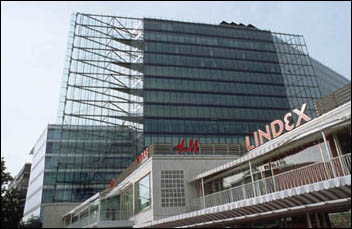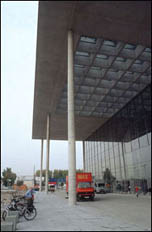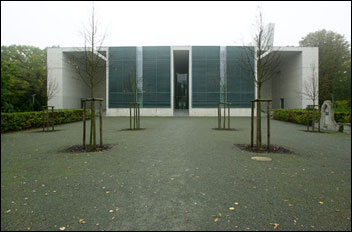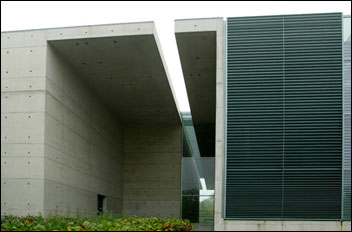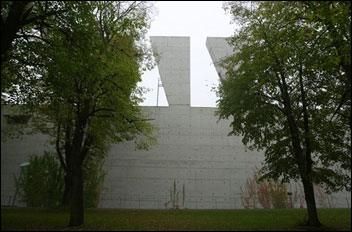Performatism, or What Comes After Postmodernism. New Architecture in Berlin
Let’s start with a short test. First, take the four or five criteria most widely used to define postmodernism. Most people would agree that these include things like the disappearance of the subject, the displacement of the real and authentic by the virtual, an ironic metaposition regarding the world and its workings, and an extreme skepticism regarding all metaphysical schemes.
You might want to delete some of these points, fine-tune them, or maybe even add more. However, being a reasonably literate person living in the year 2002 A.D., you should have no trouble coming up with a good working notion of what postmodernism is. Now, take that definition you have – whatever it is – and apply it to the last fairly sophisticated movie you’ve seen (no cheating here: big budget Hollywood genre films don’t count).
Think very hard about the movie, and then about your criteria. Did all of them fit ? Did just one of them fit (if you squinted your eyes a lot)? Did any of them fit? My guess would be that they didn’t, or at least that if they did, you had to do an awful lot of squinting.
Since I don’t know what you saw, I’ll tell you about the last movie I was in. It was the Amélie’s World, a very popular film not just in France, but also in America and the rest of continental Europe. Amélie, in case you haven’t seen it, is about a lonely young waitress in a French bistro who finds out she can make other people happy by setting up miraculous little situations that change their lives. In short, she plays God on a small, personal scale.
She makes a lonely middle-aged fellow happy by letting him find the box of toys he hid as a child. She lures her reclusive father out into the world again by abducting his garden gnome and having a stewardess friend send pictures of it poised in front of tempting foreign sightseeing attractions.
She effectively silences the abusive boss of a retarded vegetable vendor by sneaking into his apartment and changing small things around (alarm clock setting, slipper size, contents of toothpaste tube) until he goes completely out of kilter, allowing his retarded victim to take over for a while.
Amélie finally meets her comeuppance when she secretly tries to bring happiness to a guy who collects and pastes together torn-up pictures from photo booths in train stations. Her neighbors and colleagues, who are by now on to her tricks, set her up too, and in the end she finds true love.
The film has some very quirky camera work (among other things it zooms in on Amélie’s nose at decisive moments) as well enough black humor and melancholy to keep it from degenerating into a sit-com or sentimental, American-style comedy.
Now, let’s try my four-point test. Point One, the disappearance of the subject, doesn’t work at all. Not only doesn’t Amélie’s particular mode of subjectivity – setting up other subjects to make them happy – not disappear, it becomes a sort of general principle that rubs off on everyone around her.
Point Two, the displacement of the real by the virtual, works, but only sort of. Setting people up to make them happy is a kind of virtual, constructed activity, whereas the result, happiness, is quite real to the people involved and actually changes their lives.
We’ll have to call this one a tie. Point Three, the ironic metaposition, doesn’t pack much of a punch, either. The movie has a comic, pseudo-documentary tone, but it certainly takes Amélie seriously enough to want to make us identify with what she’s doing.
There is, I suppose, a certain kind of situational irony involved, since Amélie can’t apply the scheme she uses to make other people happy to herself. However, when other people pick up the idea and apply it to her, it works for her, too. So if this is irony, it’s irony of a positive, beneficial kind.
Point Four, extreme metaphysical skepticism, raises an interesting attitude problem. If you’re skeptical about all metaphysical schemes in the usual poststructuralist way, then in this case your’re going to be very skeptical about the possibility of making other people happy.
In fact, you’ll probably assume that the whole notion of making people happy as practiced in the movie is a construct or deceit. If you argue this way, though, you’ll be missing the point.
For what the movie is saying is that it doesn’t matter if happiness is a construct; what matters is the result. The movie doesn’t give a hoot about whether we know that happiness is a construct; the point is to be so. And Being of any kind is, of course, absolute anathema to postmodernism.
For a postmodernist, Being is always dependent on Something Else, which is in turn dependent on a whole tangle of other Something Elses which we aren’t ever be able to control or understand in their entirety.
The best we can do under these circumstances – at least as postmodernists – is to affect an ironic attitude demonstrating that we are aware of this situation enough to describe it or perhaps also slyly subvert it, but not enough to change it in any substantial or lasting way.
This is also what postmodernists mean when they talk about the end of history (another criteria I could have included above). Unusual or unexpected events do occur, but their dependency on previously existing Something Elses always keeps them from turning into something truly original.
The problem now, as I see it, is that artist, writers, filmmakers, and architects have stopped catering to this ironic attitude and are now setting up characters (and ourselves) to be happy, to love, to believe, to experience things anew, to transcend etc.
Because these set-ups involve making characters carry out difficult, one-of-a-kind acts or performances, I’ve called this new development performatism.
Performatism represents a radical break with postmodernism, though it in some respects still remains obligated to it – new epochs, after all, have to start out from somewhere.
At the same time, performatism is not just a rehash of modernism. Unlike modernism, performatism does not pretend to create authenticity or to experience things directly.
As we’ve seen in the case ofAmélie, emotional states of being (happiness, love, whatever) are set up or constructed; there is always some sort of intermediary involved. Unlike postmodernism, though, performatism wants us to experience constructed states of being more or less involuntarily.
In other words, it sets characters up in such a way that they experience something truly new and profound. The same, of course, applies to us as viewers.
We are set up in such a way that we have almost no choice but to identify with the characters (the reviewer for the New Yorker, Anthony Lane, put this very nicely when he said of Amélie that the number of people who dislike this movie “is almost into double digits”(Lane, Anthony. 2001. “In the Shadows. Coen brothers crime, and a French phenomenon.” New Yorker November 5th. 104-105.)).
Needless to say, postmodernists consider performatism humbug. This is because they’re only in one very limited kind of thing, namely the ironic knowledge that being is conditional and contingent.
Performatism disarms this attitude by demonstrating from the very beginning that knowledge isn’t the most important part of human experience. After a while, it doesn’t matter if the characters know that Amélie’s little tricks are a deceit, and it certainly doesn’t matter if the viewer knows (indeed, that’s what the movie’s plot is all about).
From a postmodernist point of view, performatist works of art or literature appear to be banal or stupid, since the success of the performances involved are independent of knowledge of what is conditioning them.
Conversely, performatist works often provoke postmodernist pretensions to ironic knowledge by placing retarded or intellectually limited characters at the center of attention. In the case of Amélie this doesn’t apply entirely, since Amélie is not, strictly speaking, stupid.
However, it is no accident that she helps the retarded vegetable vendor Lucien get his due, and it is certainly also no accident that Lucien liberates Amélie’s painter neighbor from a state of posthistorical monomania.
The neighbor, who keeps on painting the same Renoir picture over and over again, at the end of the movie begins to paint in Lucien’s primitive, splashy style – the new is still a copy, but now at least it’s based on the work of a natural, fully unselfconscious naif.
I started off with a cinematic example of performatism because it seemed to me the easiest way to demonstrate this major epochal shift to the reader. Almost everyone goes to the movies regularly, and movies tend to react to popular trends more quickly than another genres do.
However, if we applied the postmodernism test to innovative works of architecture built within the last seven or eight years we would get pretty much the same results.
If you take standard criteria like the ironic, eclectic citation of previous styles, use of popular architectural vernacular in “serious” buildings, or the extreme relativization of spatial coordinates like in/out or up/down, you’ll find that very few contemporary buildings, if at all, display these by now familiar canonical features of postmodernism.
What you will find in their stead are a set of techniques that are aimed at putting on architectonic performances – performances that represent spatial analogies to the situations found in Amélie and other narrative works of art.
Without further ado, I’d like to introduce the main criteria for architectonic performatism and then provide some examples from Berlin, which quite possibly has the most dynamic architecture scene of any city in the world.
Performatist architecture works by suggesting the possibility that buildings can transcend their material substrate. Obviously, this is a construct. We know that buildings can’t transcend their anchoring in gravity, mass, or materiality, but what now counts is that they try to do so – hence the notion of performativity. The most fundamental device of architectonic performatism is what I call theistic creation.
Acts of theistic creation in architecture may be thought of as analogous to acts attributed to a theistic, personal God in the real world. Having created a frame (the world) in which people can act of their own free will, a theistic God intervenes radically, but incompletely, within it.
If you are a theist believer, you will take the massive, sweeping nature of His acts for proof of His existence. However, the reasons for these acts will always remain unknown to you, and indeed may even seem vexing, cruel, or pointless. By way of analogy, the theistically oriented or performatist architect “plays God” by creates a frame (a building) in which he or she then radically intervenes.
In architectonic terms, this usually involves involves slicing mass out of buildings on a grand scale (less frequently, the architect will add mass to them in unusual places). The user or viewer is supposed to feel the powerful, preterhuman hand of the architect rather than to perceive some sort of interplay of familiar ornamental forms, as in postmodernism, or some compelling technical principle, as in modernism.
A second major technique involves transparency, or dematerialization. Performatist structures evoke the possibility of transcending materiality by presenting it in the form of transparent, seemingly dematerialized planes.
Performatism reifies, albeit imperfectly, the possibility of transcending materiality per se without really revealing anything particular about a structure’s inner workings or essence.
Another key element of performatist architectonics is triangulation. The triangle is a minimal geometrical figure embodying the transition from one- to two- dimensionality (from the horizontal to the vertical).
Semantically it can be thought of as a figure expressing the opposition divergence/convergence. The apex of the triangle acts as an index sign pointing to something particular, whereas the two lines forming it may be thought of as extending on out into infinity.
Triangular structures, when resting on their bases, are stable below and strong above; lean-tos and house gables exploit these features.
Performatism takes triangularity and makes it into a figure of belief, rather than of functionality: it tilts it and positions it in precarious, unexpected ways suggesting that its normal function of providing shelter and stability has been overcome.
Kinesis is less frequent, but nonetheless important device in performatist architecture. Indeed, it is probably the most drastic way to exemplify transcendence with architectonic means: kinetic devices suggests that a static object, a building, is doing something that it cannot normally do, i.e., move.
Usually, this takes place through triangulation. The oblique side of the triangle suggests that a dynamic, “sliding” relationship between up and down is being mediated by the building.
A device related to kinesis and theistic creation is what I would call impendency (from impendere, to hang over, threaten). Buildings of this kind are architectonically so dynamic that they seem to be on the verge of collapse; they work, as it were, by putting fear of the Lord and awe of the architect into the viewer at the same time.
This sublime drama is human, and not technical, as in modernism: it is an expression of the architect’s will or willfulness, rather than a demonstration of technical prowess.
Performatist architecture occasionally thematizes wholeness and closure. In such cases we find novel, egg-shaped structures rather than the geometric, rational circles of modernism.
You might say that the egg shape leads to a “mild” version of performatism: it suggests closure and unity but at the same time presents it as something irregular, as not entirely rational.
As is the case with impendency, performatist architecture often employs frames and framing as tokens of theistic self-revelation.
Frames may have missing chunks suggesting a paradoxical confluence of architectonic might and impotence in the face of the Beyond; very often the frame seems to disassociate itself radically from its content (or vice versa).
And now it’s time for a virtual stroll through Berlin. Before I begin, the reader should be aware that I will be treating buildings in terms of their place in the performatist scheme rather than in regard to their urban context, the oeuvre of their planners, and their success or failure as functional and aesthetic objects, i.e., the usual subjects of architectural criticism.
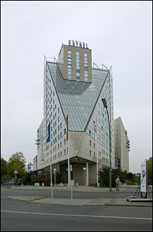 The Estrel Hotel is performatism at its most exuberant. The hotel’s main structure is a gigantic wedge whose apex points down toward a specific spot on earth (you, the observer) while its open angles stretch upwards and outwards toward the infinite bounds of the sky. The upwardly directed push from solid, gleaming mass to nothingness is accentuated by an empty frame above extending the wedge structure below.
The Estrel Hotel is performatism at its most exuberant. The hotel’s main structure is a gigantic wedge whose apex points down toward a specific spot on earth (you, the observer) while its open angles stretch upwards and outwards toward the infinite bounds of the sky. The upwardly directed push from solid, gleaming mass to nothingness is accentuated by an empty frame above extending the wedge structure below.
The sky itself then fills out the emptied earthly construct – a common performatist device suggesting a transcendent goal. The most striking feature of the building is the enormous wopperjawed wedge resting on the inclined plane of the building’s forefront.
You could think of it as an impendent threat (the proverbial ton of bricks about to slam down on your head) or as a load on a ramp miraculously defying the laws of gravity. The theist implications are here, I think, self-evident: as the German architecture critic Falk Jaeger writes, “you can almost imagine how the architects took a knife and carved the form out of a block of clay” (Jaeger, Falk. 2001. Architektur f¸r das neue Jahrtausend. Stuttgart. 179.).
 The Kant Triangle is extravagantly performatistic because it really and truly moves: the triangular gizmo on top is a kind of gigantic weather vane or sail that actually shifts when the wind builds up enough (initially unaware of this fact, I made a mental note to stay clear when the first big gust of wind came along).
The Kant Triangle is extravagantly performatistic because it really and truly moves: the triangular gizmo on top is a kind of gigantic weather vane or sail that actually shifts when the wind builds up enough (initially unaware of this fact, I made a mental note to stay clear when the first big gust of wind came along).
The oversized weather vane does have a function of sorts – it can be used to clean the building – but there are probably easier and less ostentatious ways to go about doing this. With this kind of building, the context is secondary.
Your attention involuntarily focuses on the giant triangle, which, depending on the way the wind is blowing, decenters itself again by pointing outward towards something in the scene around it.
This is a good working example of what I would call transcendent functionalism. The “function” of the vane is to attract attention to itself so that it can refocus that attention elsewhere once again; the agency guiding that function (the wind) ispart of a bigger, natural, ineffable frame that transcends us all while at the same time leaving a spatial, terrestrial marker incontrovertibly demonstrating its existence.
The Neues Kranzler Eck Shopping Mall provides good examples of almost all central devices of performatism. The extreme acute angle of the transparent, triangulated facade “wastes” space in an extravagant, visible way incompatible with any quotidian function.
Paradoxically, this grand display of ornamental excess is derived from the Euclidian axiom that two non-parallel planes in space must converge. The true function of this rationally motivated ornamentation would indeed appear to be to direct the observer’s gaze upwards in the most radical possible way.
As in many other structures, the half-built transparent roofing and the incomplete frames suggest that the heavens above are the real, ultimate roof of the work of art (designed either by a theist, personal God interested in building a shopping mall, or a theist, incompletely omnipotent architect, in this case Helmut Jahn).
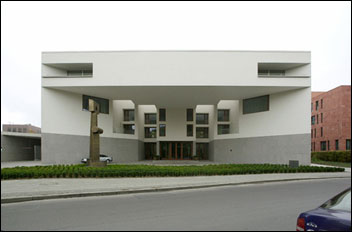 A willful, theist architect has gutted the The Baden-Würtemberg building, but in a goal-directed, elegant way made clear by triangulation. The horizon lines leading into the building serve to draw us involuntarily into its space, even as we are taken aback by the drastic, non-functional removal of so much matter from a rectilinear volume. Further rectangular incisions in the triangular incision heighten this effect even more.
A willful, theist architect has gutted the The Baden-Würtemberg building, but in a goal-directed, elegant way made clear by triangulation. The horizon lines leading into the building serve to draw us involuntarily into its space, even as we are taken aback by the drastic, non-functional removal of so much matter from a rectilinear volume. Further rectangular incisions in the triangular incision heighten this effect even more.
The Paul Löbe Building is a textbook example of performatist technique. The large chunks cut out of the roof make a transcendent, ineffable frame – the sky – an intrinsic part of the entire architectural statement.
This is a common, but very effective performatist device. The spindly pillars of the roof look as if they could be knocked over with one swift kick (in the aftermath of September 11th, one wonders if the architect has had any second thoughts about this impendent feature).
The large cuts made in the side of the building are huge theist incisions supposed to make it possible for passersby to observe, at least superficially, just what their elected representatives are up to.
If you ever have the misfortune to die and be cremated in Berlin, your friends and family will have the good fortune to mourn your passing in the beautiful and evocative Treptow Crematorium.
By all appearances the theist creator seems to have carved it out of a single block (in reality the building is made of plain old poured concrete. Slices in the roof suggest a rationally planned passage to heaven as well as the ease with which even the most solid-seeming material can be made to evanesce.
Dematerialization is also suggested by the transparent walls; you can literally see through the entire building. Very effective is also the kinetic manipulation of the facade; the louvres make matter appear and disappear upon command.
The ornamental, absolutely superflous triangulation defining the three ominous smokestacks suggests upward, transcendent expansiveness while pointing downward, as it were, at thee. Inside, the 29 light-tipped columns arouse universal wonder.
It is hardly necessary to comment on how they simultaneously transcend functionality, materiality and “mere” ornamention. An at first curious, but on second thought absolutely characteristic feature is the egg suspended from a barely visible wire hung from the ceiling above a round pool.
Here, Schultes and Gill are evidently citing pagan symbols of originary unity (I invite the reader, though, to decide what is more important: the performative, magical representation of that unity or the derivative fact of its citation).
Also striking are the curiously tiered walls of the Crematorium with their regular rows of holes and casket-like incisions with sandpiles at their base.
The holes contain lights which, when lit, performatively suggest the dispersion of matter from within; the sandpiles are no doubt meant to embody the cyclicity implicit in the saying “ashes to ashes, dust to dust.”
 Dubbed the “Chancellor’s Washing Machine” by the Berliners, the swirling, grandiose Federal Chancellery, which is the seat of executive power in Germany as well as the Chancellor’s home, has been accused of being gigantomanic and excessively garish.
Dubbed the “Chancellor’s Washing Machine” by the Berliners, the swirling, grandiose Federal Chancellery, which is the seat of executive power in Germany as well as the Chancellor’s home, has been accused of being gigantomanic and excessively garish.
The Chancellery itself is a good deal larger than my picture suggests. It is flanked by two massive office blocks, and from the distance its boxy exterior does indeed resemble a giant, outlandish household appliance (the popular idea of the building as a kind of gargantuan washing machine fits in quite well with my notion of transcendent functionalism).
The facade, which is the most striking and widely photographed feature, works by radically disassociating frame and content in both vertical and horizontal space.
As in the Treptower Crematorium, it is possible to see through the vast building entirely; the structure seeks in this way to disavow its own materiality. Wings have been sliced into the roof suggesting both flight and the overcoming of matter; the flight theme is echoed further below by the pterodactyl-like roof stretched out over the entrance.
The profusion of chopped-off pillars suggests theist willfulness mitigated by natural growth (the trees on top).
On the horizontal level, the first floor appears to be disassociated entirely from the ground floor; similarly, the louvres in back of the pillars disect and “move” space on a horizontal axis.
On the ground, the oddly configured grass strips repeat the wing patterns above and point us toward the entrance. In general, the building “opens” out towards us and tries to draw us into its space, which is then made to dematerialize as much as possible.
This effect of openness, transparency, and upwardly bound movement is entirely conscious and political. Schultes wanted to make this German equivalent of the American White House as open to the public view as possible, and was bitterly disappointed that a Citizen’s Information Center he designed was not built in front of the Chancellery (cf. Schultes 2001).
 The Lemon Office Building is performatism’s way of squaring the circle. Triangulation, which normally involves stylizing convergence and divergence, is combined here in a paradoxical way with circularity and wholeness.
The Lemon Office Building is performatism’s way of squaring the circle. Triangulation, which normally involves stylizing convergence and divergence, is combined here in a paradoxical way with circularity and wholeness.
Seen from the road, the Lemon Building seems to float over its base, which is marked by crisp incisions that seemingly undermine its wholeness and stability – all the work of an architect not quite of this world.
In this structure, the occupants of the building unwittingly participate in the performatist plan: undrawn, the window shades realize transparency; drawn, materialization.
This spontaneous individual activity of the building’s users – something modernist architects disdained as a gross disruption of their rigorous symmetries – is now integrated into the total aesthetic scheme.
This, of course, isn’t all. There are at least several dozen more new buildings in Berlin that flunk the postmodernism test and fit my criteria; space limitations (not to speak of the time that would be needed to photograph them all!) prevent me from presenting even more. But by now I think the message is clear. Postmodernism is dead, performatism lives!
Parts of this article appeared in Anthropoetics No.7, 2 Fall 2001/Winter 2002 www.anthropoetics.ucla.edu/ap0702/arch2.htm). Readers interested in a full semiotic explanation of performatist theory should consult that article as well as my original performatist manifesto in Anthropoetics 6, 2 Fall 2001/ Winter2002 (see under www.anthropoetics.ucla.edu/anthro.htm).

